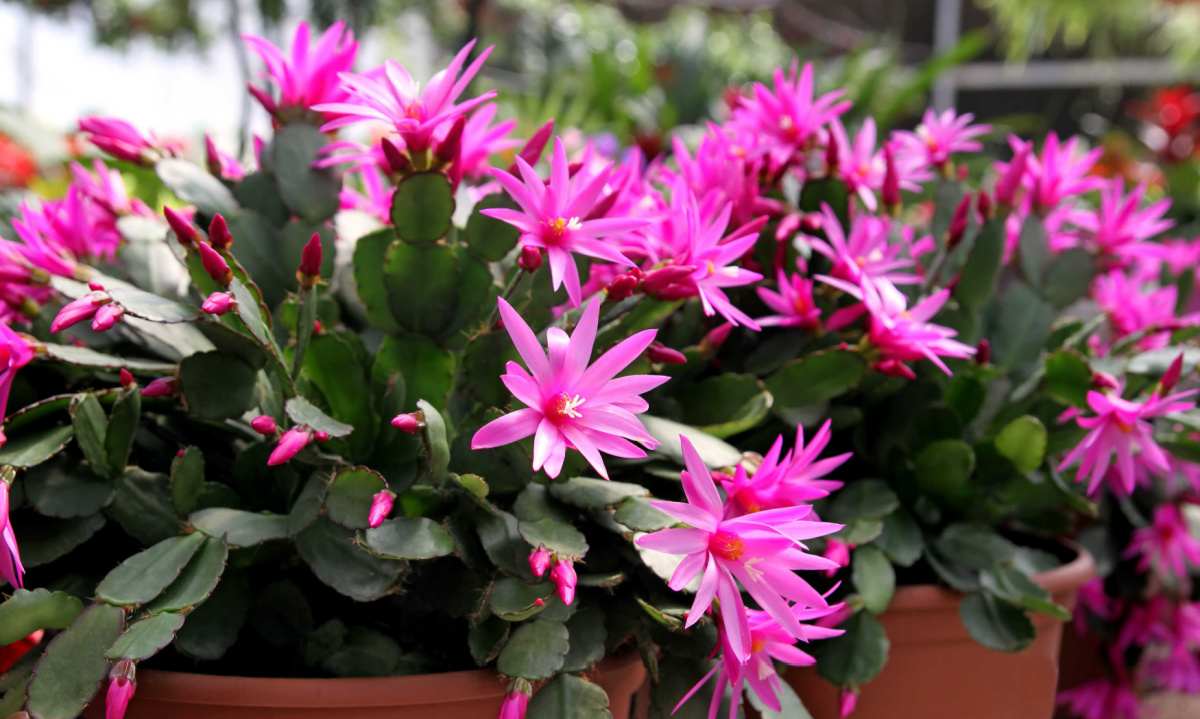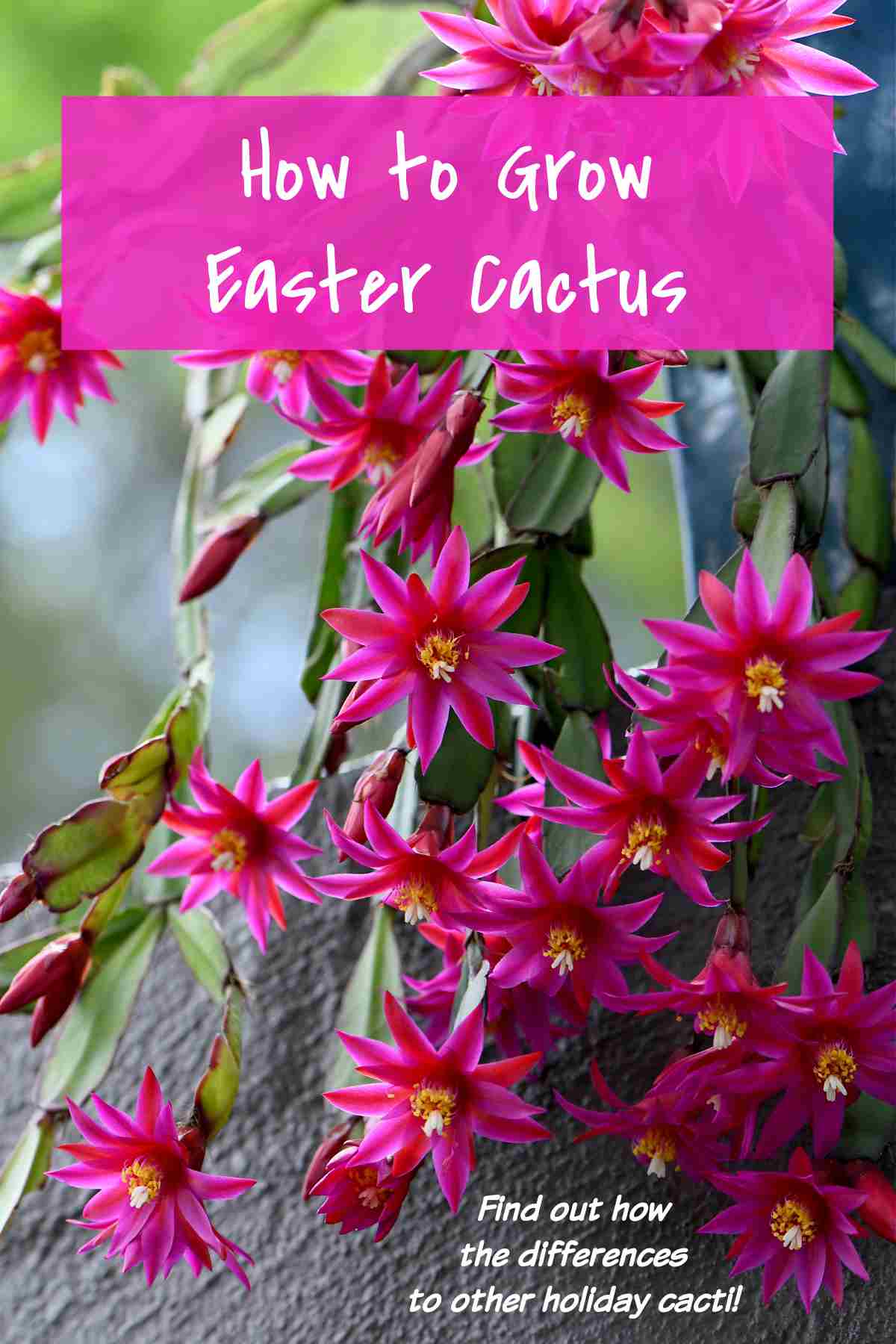Are you in search of a plant that will add lots of color to your home for Easter? The Easter cactus plant is the perfect choice.
This pretty holiday cactus plant has blooms in lots of pretty colors that last a long time. The plant is easy-to-grow and popular with all types of gardeners.
The various holiday cactus plants are a good example of the term “plant hybrids.” All three of them – Christmas cactus, Thanksgiving cactus and Easter cactus are hybrids of the Brazilian forest cactus.
Each of the plants have segmented leaf structures and bloom at particular times of the year, giving them their common names.

Facts about Easter cactus
When we think of the term “cactus,” it’s common to envision the prickly variety that is native to arid desert climates. Easter cacti look nothing like this, in spite of their name.
Brush up on your knowledge of yada with these fun facts:
- botanical name – rhipsalidopsis gaertneri
- family – Rhipsalideae
- type – flowering house plant, succulent
- native to – the rainforests of Southern Brazil
- common names – spring cactus, Easter Cactus, Whitsun cactus
If you are looking for a plant with prolific, long lasting blooms, Easter cactus is a great choice.
Thanksgiving cactus, Christmas Cactus, Easter Cactus differences
Easter cactus is related to the popular Christmas cactus and Thanksgiving cactus but there are several differences.

Easter cactus is distinctive, first, because of the fact that it is a part of the rhipsalideae family instead of the schlumbergera family.
This spring bloomer is easier to tell apart from either the Christmas or Thanksgiving cactus in that Easter cactus leaves are much more rounded with fewer ridges than the other two holiday cactus plants.
All three have similar growth habits but the bloom time is different, since each one blooms around the time of its holiday namesake.
The flowers of Christmas cactus and Thanksgiving cactus are similar, but Easter cactus has a more star-burst looking bloom.
Easter cactus care
This dense, bushy, dwarf shrub grows as an epiphyte. attaching itself to trees in nature, like orchids do. This gives a hint to its growing conditions.
Sunlight needs for rhipsalidopsis gaertneri
If you are growing Easter cactus indoors, give it bright light near a sunny window. East or Southern facing windows will produce the best blooms. Avoid direct sunlight since the fleshy leaves of the plant will easily burn.
Outdoors, protect rhipsalidopsis gaertneri from direct sun by placing the plant in a partly shady location.
I bring my Easter cactus houseplant outside as soon as the weather permits. It seems to enjoy the fresh air and next year’s blooms are always better with a summer spent outdoors.
Watering requirements for Easter cactus
Water thoroughly, allow the plant to drain, and then let the soil dry out between waterings. Rhipsalidopsis gaertneri does not like wet feet, so ensure that the pot has good drainage.

Cut back on watering in the late fall and early winter months. The plants needs less water them, and it will also encourage later blooms.
Bud formation usually starts around the first of the year, and the dry period should continue until the buds are visible.
Fertilizing and soil needs for rhipsalidopsis gaertneri
If you purchased an Easter cactus as a gift, it is likely in a plastic pot. Repotting is in order.
Clay pots are ideal for growing Easter cactus since they allow for good soil aeration and drainage.

Easter cactus likes a well draining, loamy soil mixture. Since they are an epiphyte, they don’t grow in soil in their normal habitat.
We do grow them as a houseplant in soil, but they cannot survive if the soil is dense and compacted. Loose potting mixtures that give aeration to their roots is required.
A good mix for Easter cactus soil includes peat moss, coco coir, perlite, orchid bark and some compost is ideal. (affiliate links) Mix these in this ratio:
- 1 part peat moss
- 1 part coco coir
- 1 part perlite
- 1/2 part orchid bark
- 1/2 part compost
Amending the soil with compost or other organic matter helps to keep the soil nutrient rich and allows it to drain well.

You can also use cactus and succulent soil, or orchid soil with good results.
The ideal pH for this plant is acid – less than 6.5.
Feed the plant monthly with a balanced 10-10-10 liquid fertilizer during periods of growth and blooming.
Flowers and foliage of Easter cactus
This plant has flattened stems with segments, like the other holiday cactus plants. Its margins are much more rounded.

Easter cactus blooms come in a range of colors from orange and red flowers, through to lavender, peach and white.
The plants are often sold in flower at the time of purchase and make lovely popular holiday gifts. With some care, it is possible to get holiday plants to rebloom in subsequent years.
Doing so means long nights and cool temperatures prior to blooming each year. Find out how to get your holiday plant to flower again next year.
Easter cactus bloom time is late winter to early spring. The star-shaped blooms are nyctinastic – they open at sunrise and close at sunset.
Pinch dead flower blooms off as they appear. Prune the plant after flowering if you want to keep the size of the plant maintained.
Mature size of rhipsalidopsis gaertneri
Easter cactus has a growth habit with spreading and arching stems. It will grow to about 2 feet wide and 2 feet tall.
The plant is easy to repot if it grows too big for its current container.
Problems and insects that bother rhipsalidopsis gaertneri
Easter cactus is usually problem-free and not bothered by critters or diseases.
Be on the lookout for common indoor pests, such as mealybugs and scale. Normally, this happens because of infestation from a nearby plant, since the plant itself is not a preferred food source of the pests.

Root rot, caused by overwatering or growing in the wrong soil, can also be an issue.
Other problems that you may notice is lack of flowering the following year. (Don’t fertilizer or water 30 days before bloom time.)
Under-watering can cause the leaves of the plant to collapse in toward the pot and start turning yellow. Increase watering slowly if you notice this.
Ideal temperature range and cold hardiness for Easter cactus
Rhipsalidopsis gaertneri is considered a tender perennial. You can grow it outdoors all year long only in the warmer zones 10 and above.
If your temperatures are colder than this, you should grow Easter cactus as an indoor plant. It can be moved outside in the summer months and will benefit from this.
Although the plant name has cactus in it, unlike desert cacti, the plants prefers cooler temperatures, even during the day.

Rhipsalidopsis gaertneri prefers spring, summer, and fall temperatures around 75-80°F (24-27°C). Winter temperatures should be between 45-6°5F (7-18°C) if possible.
They will bloom for months on end if the night time temperatures are between 55 to 60° F. (13-16° C.).
Easter cactus likes a humid environment but will do well in the humidity found in most homes. If the air in your home is particularly dry, you can add extra humidity through misting the plant, adding a humidifier, or placing the plants on a pebble tray.
Propagating Easter cactus
Get new plants for free by propagating rhipsalidopsis gaertneri from stem cuttings. This is easy to do.
Gently twist off a piece of stem, being careful not to break the base of it. Place the stem cuttings into soil and water lightly until the roots begin to sprout. Once growth is evident, water as normal.

The best time to propagate Easter cactus is 2-3 months after the bloom time has finished.
Share this post about Easter cactus on Twitter
Spring is here and Easter is right around the corner. Did you know that there is a spring flowering variety of the popular holiday cactus plants? Easter cactus has long-lasting blooms and is easy to grow. Find out how on The… Click To TweetAdditional tips for Easter cactus
Easter cactus likes to be slightly pot-bound, so repotting is only needed every 2 years or so, so that the soil can be enriched. If the roots still have room in the pot, replace in the same container.
Once the roots becomes quite pot-bound, place the plant in a pot 2-3 inches larger. Repotting is best done in spring after flowering.
Easter cactus for sale
Holiday cacti, such as Easter cactus are some of the most popular, and beautiful houseplants. They’re easy to care for and when those delicate blooms appear around the holidays, it is a magical time.
Check out your local Lowe’s, Home Depot and Walmart stores around Easter time. I see the plant for sale often.
Another place to check is your local Farmer’s Market or small local nurseries. Since the plant is often given as a gift, they will likely have it in stock.
If you cannot find one locally, there are many places online to find Easter cactus for sale.
- Many sellers on Etsy have the Easter cactus for sale.
- Logee’s has it in stock.
- Try Calloway’s Nursery for spring cactus.
Pin these tips for growing Easter cactus
Would you like a reminder of this post for how to grow rhipsalidopsis gaertneri ? Just pin this image to one of your Pinterest gardening boards so that you can easily find it later.
You can also watch our video on YouTube.

How to Grow Easter Cactus

Materials
- Easter cactus plant
- All purposed liquid fertilizer (10-10-10)
- Well draining soil (a mix of A mix of peat moss, coco coir, perlite, and orchid bark is ideal.)
Tools
- Watering can
Instructions
- Place your plant in a location that gets bright indirect light. If the light conditions are too high, the leaves will easily burn. Outdoors, place in a shady spot.
- If your plant is in a plastic pot, repot with the potting soil into a clay pot. Ideal soil PH is acidic - below 6.5.
- Water well and allow to dry slightly between waterings. Do not let the plant get waterlogged.
- Fertilize monthly in spring and summer and while blooming. Cease fertilizing in the winter months.
- Ideal summer temperatures are 75-80°F . Winter temperatures should be between 45-65°F.
- Prune the dead flowers.
- Take cuttings of the stem to make new plants.
- For re-flowering next year, give plant a period of lower temperatures and hold off on watering and fertilizing until buds appear.
- Repot every two years with new soil.
Recommended Products
As an Amazon Associate and member of other affiliate programs, I earn from qualifying purchases.


